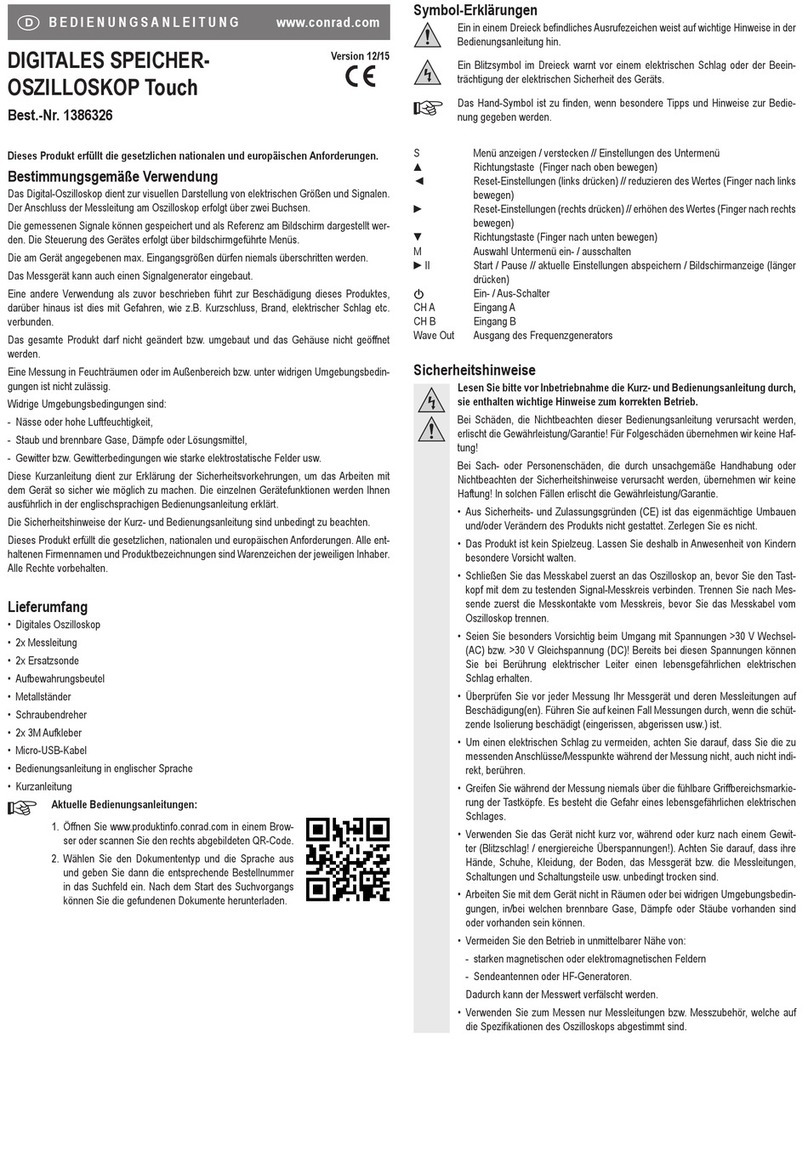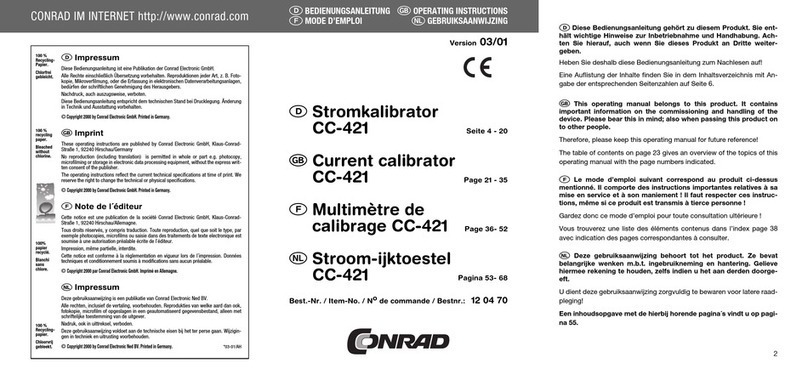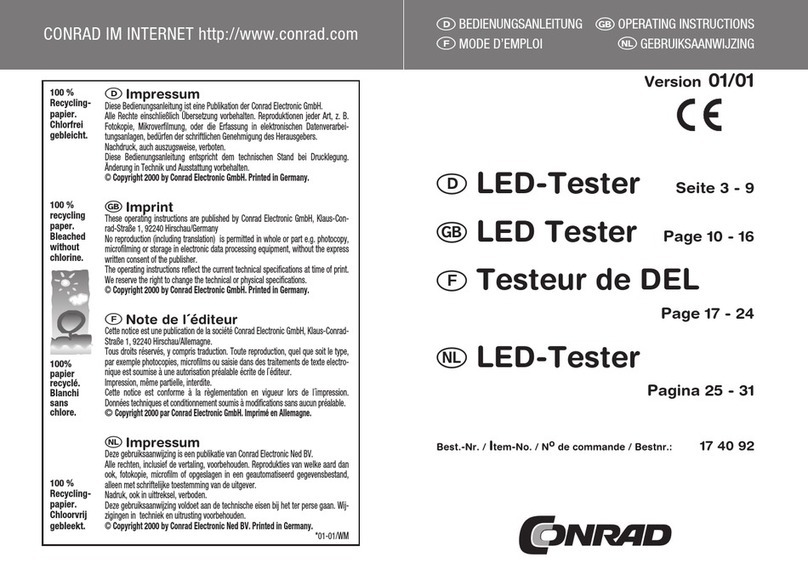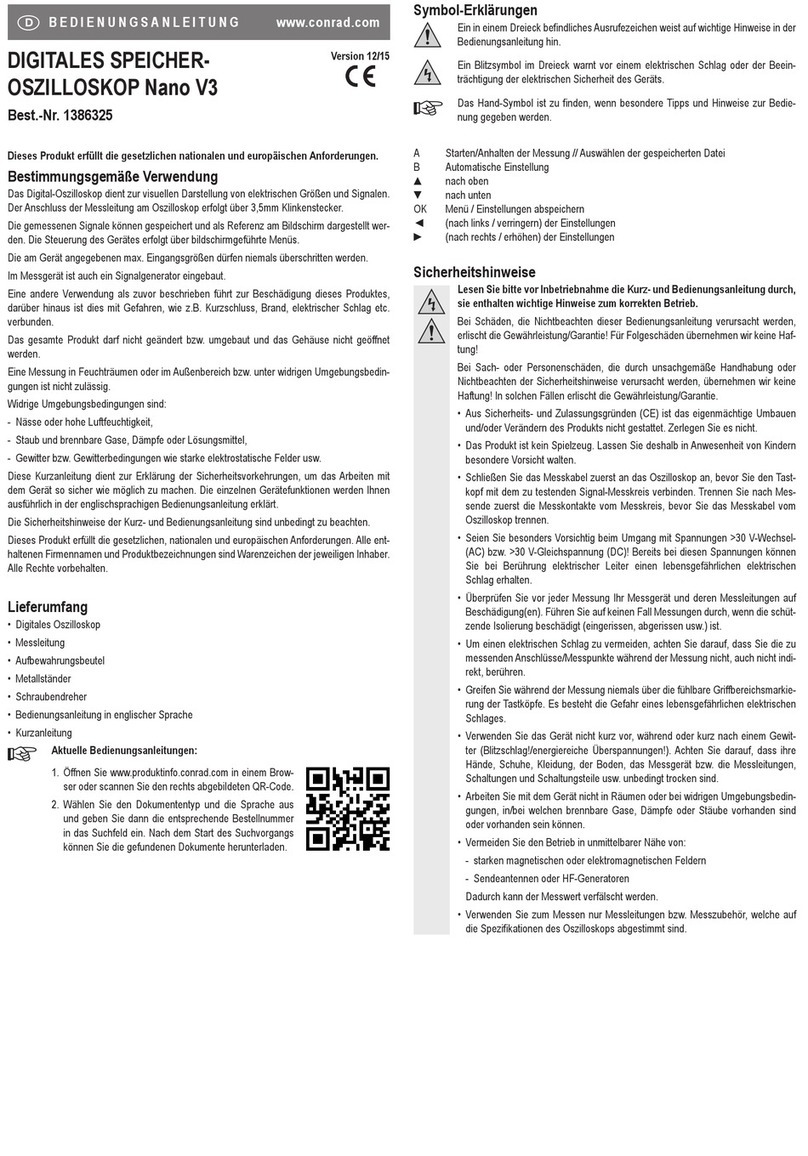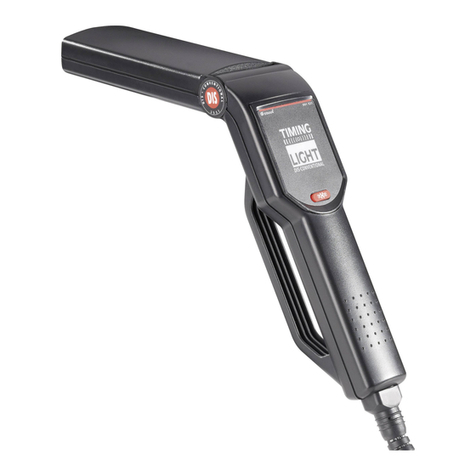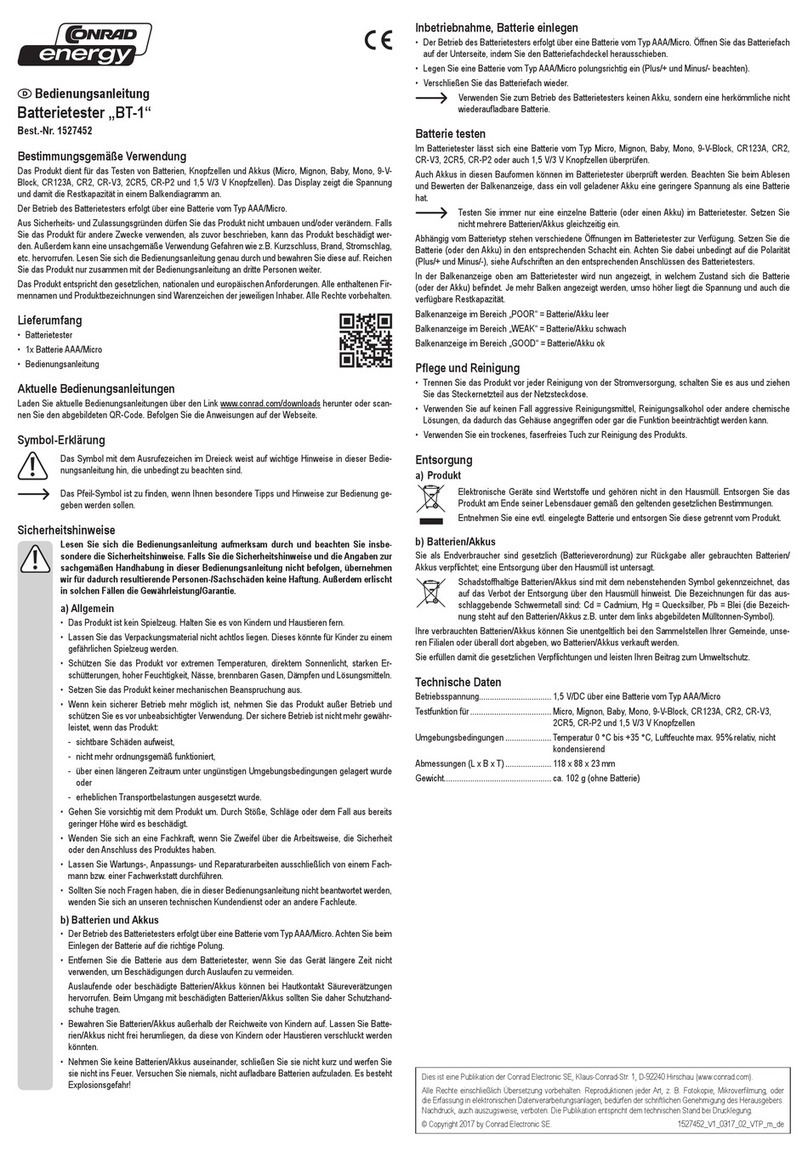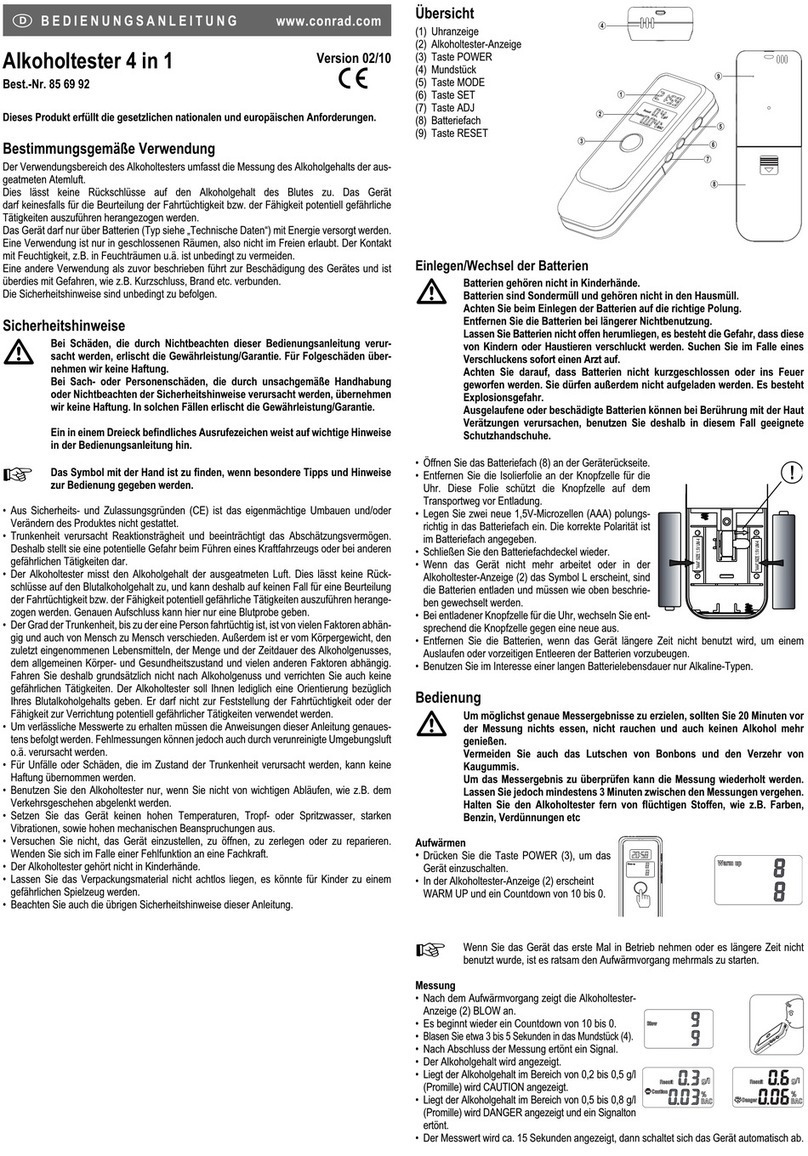Version 04/03
Knopfzellen-Tester °
Best.-Nr. 10 05 68
Diese Bedienungsanleitung gehört zu diesem Produkt. Sie enthält wichtige
Hinweise zur Inbetriebnahme und Handhabung. Achten Sie darauf, auch wenn
Sie dieses Produkt an Dritte weitergeben. Bewahren Sie deshalb diese
Bedienungsanleitung zum Nachlesen auf !
Bestimmungsgemäße Verwendung
Prüfen von 1,5 - V - Knopfzellen. Eine andere Verwendung als zuvor beschrieben,
führt zur Beschädigung dieses Produktes. Die Sicherheitshinweise sind unbedingt
zu beachten!
Sicherheitshinweise
Der Batterietester erfüllt die Richtlinie 89/336/EWG.
Es ist nur für 1,5V Gleichspannung zugelassen.
Der Batterietester ist kein Spielzeug!
Die Polarität ("+" = Plus und "-" = Minus) darf nicht verwechselt werden.
Gebrauch
Die Knopfzellen werden während der Messung mit 270 uA (0,27 mA) belastet. Der
Durchmesser der Knopfzellen darf im kleinsten Prüfschacht ca. 6 mm nicht über-
schreiten. Dieser Schacht eignet sich z. B. für die Zellen 516, 521, 526, 616, 621,
626, 364, 377 usw.
Der mittlere Prüfschacht ist für Zellen mit max. 8 mm Durchmesser geeignet, wie z. B.
716, 721, 726, usw. Der untere "große" Schacht ist für Zellen mit max. 12 mm
Durchmesser geeignet, wie z. B. 916, 921, 926, 377, 357, 373, 397, LR 43, LR 44,
AG 10, AG 13, usw.
Unverbrauchte Knopfzellen, lassen sich im "Drehfach" im Checkergehäuse aufbe-
wahren. Drücken Sie dazu leicht mit den Zeigefinger in den oberen Gehäuseteil
(über der Anzeige).
Zur eigentlichen Messung drücken Sie die zu prüfenden 1,5-V-Knopfzellen (LR44,
Renata 397, AG10 usw.) entsprechend ihrer Größe polungsrichtig ("-" unten, "+"
oben) in den jeweiligen Prüfschacht, bis eine Anzeige erfolgt:
Befindet sich der Zeiger im grünen Bereich, beträgt die Zellenspannung mehr als
ca.1,1 V. Die Batterie ist einsatzfähig.
Befindet sich der Zeiger im gelben Bereich, beträgt die Zellenspannung mehr als ca.
0,9 bis 1,1 V. Die Batterie ist schwach und somit nur noch für Verbraucher mit
geringster Stromaufnahme verwendbar. Bei vielen Geräten können bereits
Funktionsstörungen auftreten.
Befindet sich der Zeiger im roten Bereich, beträgt die Zellenspannung weniger als
ca. 0,9 V, ist die Batterie verbraucht und muß umweltgerecht entsorgt werden.
Achtung!
•Achten Sie bei defekten, verbrauchten Batterien unbedingt darauf, daß es
sich dabei um Sondermüll handelt und daß diese somit umweltgerecht ent-
sorgt werden müssen. Ihre verbrauchten Batterien können Sie unentgeltlich
bei den Sammelstellen Ihrer Gemeinde, unseren Filialen oder überall dort
abgeben, wo Batterien oder Akkus verkauft werden. Dort befinden sich spe-
zielle gekennzeichnete Sammelbehälter. Verbrauchte Batterien dürfen nicht
über den normalen Hausmüll entsorgt werden.
•Der Batterietester ist absolut wartungsfrei, da er keine auswechselbaren
Teile beinhaltet. Es darf auf keinen Fall geöffnet werden. Auch nicht zu
Reparaturzwecken! Wird das Gerät trotzdem geöffnet erlischt der
Garantieanspruch.
•Die Prüfung und Anzeige erfolgt nur annäherungsweise und bedeutet nicht,
daß die jeweilige Batterie für alle Anwendungen ausreichend Restkapazität
aufweist.
BEDIENUNGSANLEITUNG www.conrad.de
Version 04/03
Round-Cell Tester °
Item-No. 10 05 68
The present operating manual forms part of this product. It contains impor-
tant information on commissioning and handling of the product. Please take
this into consideration when you pass it on to third parties. Keep this operat-
ing manual for future reference!
Prescribed Use
This product is intended for testing 1.5 V round cells.
Any use other than the one described above damages the product. Always observe
the safety instructions!
Safety Instructions
The Round-Cell Tester complies with guideline 89/336/EEC.
It is approved only for 1.5 V direct voltage (DC).
The Round-Cell Tester is not a toy!
Always ensure correct polarity ("+" = positive pole and "-" = negative pole).
Operation
During measurement, the round cells are charged with 270 uA (0.27 mA). The diam-
eter of the round cells must not exceed approx. 6 mm for the smallest testing shaft.
This shaft is suited e.g. for the cells 516, 521, 526, 616, 621, 626, 364, 377 etc.
The middle testing shaft is suited for cells with a maximum diameter of 8 mm, such
as e.g. 716, 721, 726, etc.
The bottom "big” shaft is suited for cells with a maximum diameter of 12 mm, such
as e.g. 916, 921, 926, 377, 357, 373, 397, LR 43, LR 44, AG 10, AG 13, etc.
Fresh round cells can be stored in the "rotary shaft" of the housing.
For this purpose, slightly press your finger into the top part of the housing (above the
indication).
For measurement press the 1.5 V round cells (LR44, Renata 397, AG10 etc.) to be
tested into the respective testing shaft according to their size and with correct polar-
ity ("-" down, "+” up) until an indication occurs:
If the indicator is within the green range, the cell voltage is higher than approx. 1.1 V.
The battery is ready for operation.
If the indicator is within the yellow range, the cell voltage is between approx. 0.9 and
1.1 V. The battery is weak and therefore can only be used for devices with low pow-
er consumption. For many devices, functional errors might already occur.
If the indicator is within the red range, the cell voltage is below approx. 0.9 V. The
battery is used and has to be disposed of according to the statutory requirements
for environmental protection.
Attention!
•Please observe that defective and used batteries have to be considered as
special waste and have to be disposed of according to the statutory requi-
rements for environmental protection. Empty batteries can be disposed of
free of charge at special collecting facilities in your town, in our subsidiaries
and in specialist shops selling batteries or storage batteries. There you can
find especially marked collecting boxes. Used batteries must not be dispo-
sed of with the household rubbish.
•The Round-Cell Tester is absolutely free of maintenance, because it does not
contain any replaceable parts. Never open the product (even not for repair)!
In case of the product being opened, all gurantees become invalid!
•The measured and indicated values are only approximate values and do not
mean that the respective round cell shows enough residual capacity for all
kinds of application!
OPERATING INSTRUCTIONS www.conrad.de
Diese Bedienungsanleitung ist eine Publikation der Conrad Electronic GmbH,
Klaus-Conrad-Straße 1, D-92240 Hirschau.
Diese Bedienungsanleitung entspricht dem technischen Stand bei Druck-
legung. Änderung in Technik und Ausstattung vorbehalten.
© Copyright 2003 by Conrad Electronic GmbH. Printed in Germany.
These operating instructions are published by Conrad Electronic GmbH,
Klaus-Conrad-Straße 1, D-92240 Hirschau/Germany.
The operating instructions reflect the current technical specifications at time
of print. We reserve the right to change the technical or physical specifications.
© Copyright 2003 by Conrad Electronic GmbH. Printed in Germany.

